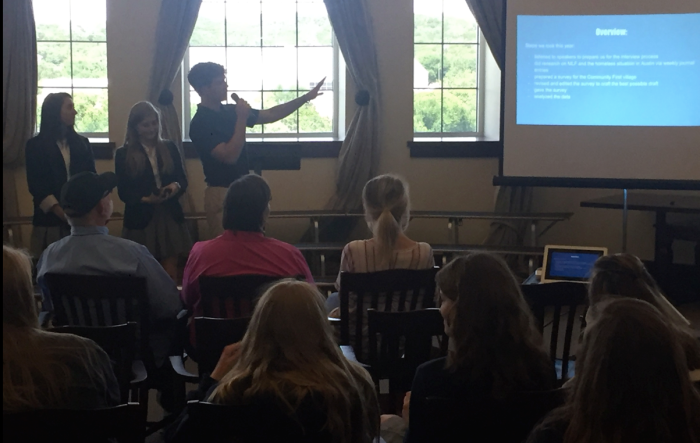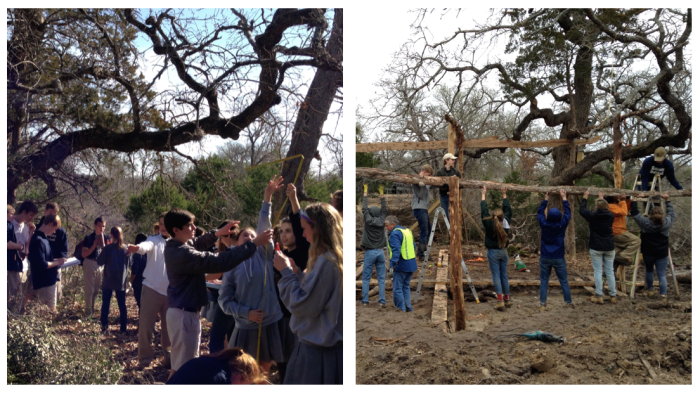This week I am leading a workshop at the 2016 Conference for the Advancement of Mathematics Teaching in San Antonio, TX on “Cultivating Mathematical Affections through Service-Learning.” The talk is on integrating service-learning projects into mathematics curriculum, specifically with the goal of impacting students on an affective level. Since this is my dissertation topic, I’ve written about it numerous times before here on GodandMath.com. In addition to the resources that you will find below, feel free to check out some of the prior posts on service learning:
- AP Conference Presentation: Serving the Community through Statistics: workshop with numerous resources for integrating service-learning into AP Statistics, presented at the 2015 AP Annual Conference. I’ll be giving a follow-up workshop at the 2016 AP Annual Conference in Anaheim, CA.
- From the Classroom to the Community (and back again): Stories of Statistics, Significance, and Service: Practical presentation on integrating service-learning in statistics given at the 2015 Joint Math Meetings.
- Serving through Statistics: the first (and largest) service project that I implemented complete with video summaries and interview with students.
- AP Stat Reading Best Practices Presentation: Short presentation I gave on service learning in AP Statistics at the 2014 AP Statistics Reading in Kansas City, MO.
- CAMT 2012 Presentation: Presentation I gave at the Conference for the Advancement of Mathematics Teaching based on the first statistics service-learning project mentioned above.
- Geometry and the Homeless: the first service-learning project I did with my geometry students. An updated version from this last school year should find its way onto the site by mid summer.
ABSTRACT:
This session will equip participants to design, implement, and evaluate service-learning projects in which students partner with non-profit organizations. Through these projects, students integrate their conceptual understanding of math with the practical functioning of their local community, ultimately gaining deeper knowledge of content and a deeper appreciation for the role math plays in society. Examples from geometry and statistics will be provided.
PRESENTATION:
You can click the image below to find the PowerPoint that accompanied my presentation.
For many of the service-learning projects that my students have completed I am indebted to the willing partnership of Mobile Loaves and Fishes. Here is some introductory information on this great ministry:
Community First! Village Goes Beyond Housing for Austin Homeless, from the Austinot
10 THINGS TO CONSIDER BEFORE IMPLEMENTING A SERVICE-LEARNING PROJECT:
The following are the foundational questions that you as an instructor should consider and reflect upon prior to implementing a service-learning project. This list is not meant to be chronological though some aspects will naturally precede others. Start by considering the course learning objectives and your method of assessing those objectives and then go from there.
1.What are the major learning objectives/big ideas/enduring understandings for your course?
2. What are real-world situations where students can apply the concepts studied in your course?
3. List some potential community partners along with some basic descriptors that may impact how your students work with each partner (ex: What is the size of the organization? What issues does the organization address? Is the organization non-profit, governmental, religiously affiliated? Etc.) In lieu of a partner organization you can also consider a general community need for students to address. List some general descriptors of the project involved in addressing this community need.
4. Look for potential matches between organizations on your list from question 3 and your responses to questions 1 and 2. If there are multiple potential matches then consider the pros/cons of each and list them. Be sure to recognize how your matching affects the organization of the project (large scale as a class v. small scale as groups), which in turn may affect your response to question 5 below.
5. Once you have begun narrowing potential community partners that offer opportunities for students to interact with course content, consider how will you assess students? What will be the final product? What expectations will you have for students throughout the project and how will you communicate that to the students?
6. How will students be organized to meet the objectives that they will be assessed on? Will students work as individuals, teams, as a whole class?
7. How will students be equipped to complete the project successfully? What will they have gained from the course up to the point of assigning the project that will aid them? What additional tools/skills/knowledge will students need as the project proceeds?
8. What will be the timeframe for the project? How will students be held accountable to the timeframe? At what points will students receive feedback on their progress?
9. Why should students care about the project? What will you do as an instructor to get student buy-in on the project?
10. How will students reflect throughout the project? What opportunities will you provide for students to pause and consider the work they have done?
HANDOUTS:
From my AP Statistics Project:
- Overview Documents:
- Survey Documents:
- Proposal Documents:
- Final Report Documents:
- Reflection Documents:
- Rubrics:
- Final deliverables:
From my Geometry project:
- Tiny house design project:
- Overall Rubric
- Overview of Tiny Victories competition (used as basis for determining criteria included in design)
- Phase I – 2D Blueprint
- Phase II – 3D
- Phases III & IV – Written Proposal & Presentation
- Reflection
- Tiny House Example (from Tiny Victories)
- Gazebo design project:

EXTERNAL RESOURCES:
- Lynn Adsit’s blog on implementing a service-learning project in AP Stats
- Issue of PRIMUS Dedicated to Successful Service Learning Resources (Volume 23, Issue 6, 2013).
- Service-Learning Session from 2011 Joint Math Meetings (Organized by Dr. Crisman)
- Mathematics in Service to the Community: concepts and models for service learning in the mathematical sciences, Charles Robert Hadlock (MAA Notes Series)






[…] CAMT 2016: Cultivating Mathematical Affections through Service-Learning: Workshop with practical resources from the AP Statistics service-learning project that formed the basis of my dissertation as well as information on service-learning projects in geometry. […]
LikeLike
[…] CAMT 2016: Cultivating Mathematical Affections through Service-Learning: Workshop with practical resources from the AP Statistics service-learning project that formed the basis of my dissertation as well as information on service-learning projects in geometry. […]
LikeLike